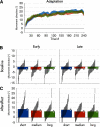Prolonged Feedback Duration Does Not Affect Implicit Recalibration in a Visuomotor Rotation Task
- PMID: 35383109
- PMCID: PMC9034752
- DOI: 10.1523/ENEURO.0447-21.2022
Prolonged Feedback Duration Does Not Affect Implicit Recalibration in a Visuomotor Rotation Task
Abstract
Visuomotor rotations are frequently used to study cognitive processes underlying motor adaptation. Explicit aiming strategies and implicit recalibration are two of these processes. A large body of literature indicates that both processes are in fact dissociable and mainly independent components that can be measured using different manipulations in visuomotor rotation tasks. Visual feedback is a crucial element in these tasks, and it therefore plays an important role when assessing explicit re-aiming and implicit recalibration. For instance, researchers have found timing of visual feedback to affect the contribution of implicit recalibration to learning: if feedback is shown only at the end of the movement (instead of continuously), implicit recalibration decreases. Similarly, participants show lower levels of implicit recalibration if visual feedback is presented with a delay (instead of immediately). We thus hypothesized that the duration of feedback availability might also play a role. The goal of this study was thus to investigate the effect of longer versus shorter feedback durations on implicit recalibration in human participants. To this end, we compared three feedback durations in a between-subject design: 200, 600, and 1200 ms. Using a large sample size, we found differences between groups to be quite small, to the point where most differences indicated statistical equivalence between group means. We therefore hypothesize that feedback duration, when only endpoint feedback is presented, has a negligible effect on implicit recalibration. We propose that future research investigate the effect of feedback duration on other parameters of adaptation, so as proprioceptive recalibration and explicit re-aiming.
Keywords: implicit recalibration; motor adaptation; visuomotor rotation.
Copyright © 2022 Maresch and Donchin.
Figures





References
Publication types
MeSH terms
LinkOut - more resources
Full Text Sources
